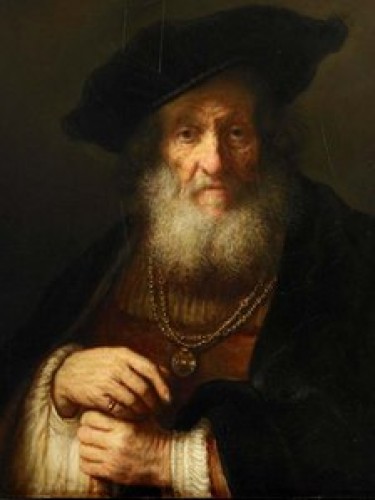From The Guardian, 28 March 2012
Left high on a library wall for more than half a century, the portrait of a rheumy-eyed old man initially seemed no different from the misattributed old masters hanging beside it.
But after more than half a century of being overlooked, it has been authenticated as a genuine and outstanding work by Rembrandt. And the identification – by the world’s leading expert on the 17th century Dutch master – will make a multimillion pound difference to its price tag.
The painting, known as The Old Rabbi, has rarely been seen by the public since it was last exhibited in 1950. Since then it has hung in the private apartments of Woburn Abbey in Bedfordshire, family home of the dukes of Bedford.
Although there is no suggestion it will now head for the auction rooms, the price difference between a genuine Rembrandt and even the best work by his studio is in the order of millions. In 2009, a world record was set for his work when a half-length portrait of a young man sold for £20m at Christie’s.
"We were all so excited at the expert verdict – the Duke was absolutely cock-a-hoop," said Abbey curator Chris Gravett, who had noticed the evident quality of the painting during his nine years working for the duke, and had become increasingly intrigued by it. This was despite competition from a collection that includes 10 paintings by Van Dyck, 12 by Reynolds, three Gainsboroughs, and a room virtually wallpapered with 24 Canalettos bought by the 4th Duke on the Grand Tour in the 18th century.
The detective work by Ernst van de Wetering, a Dutch art historian and chair of the Amsterdam-based Rembrandt Research Project, has also restored the reputation of another suspect painting – a portrait of the artist’s wife Saskia owned by the Gemäldegalerie in Berlin.
Van de Wetering, who spent a long day at Woburn poring over the panel, now believes the two pictures are a pair, linked by details of costume, pose and jewellery – particularly the rings on their beautifully contrasted hands. The young woman’s smooth flesh is markedly different from the tissue-paper-like crinkles of the old man’s skin.
He believes the pictures represent the biblical story of the exiled Ruth who married the kindly but much older Boaz.
Both appear to be painted on mahogany panels from the same packing case which originally held sugar from the West Indies. The Berlin painting is dated 1643, but Van de Wetering believes the slightly later date on the Woburn painting was added after the painting was completed.
Gravett has contacted the Berlin museum, and hopes one day the two paintings can be displayed side by side.
Authenticating Rembrandts is notoriously tricky, and many paintings in national and private collections have been in and out of favour. Frequently hard up and on occasions bankrupt, Rembrandt took on alarming quantities of work, was helped by his pupils and studio assistants and sometimes overpainted earlier works.
Since its brief outing to an exhibition of treasures from Woburn Abbey at the Royal Academy in 1950, where its authenticity was questioned, The Old Rabbi has hung high up in the private library among a group of paintings which have turned out not to be what previous dukes of Bedford had hoped, including a "not Van Dyck", a "not Hogarth", and two others not by Rembrandt.
Although there is no reference to The Old Rabbi in the family archives before a mention of it being cleaned in 1791, Gravett believes it was probably acquired with the two "not Rembrandts" in the 1740s.
It will now be taken down and displayed at head height, as the star exhibit among the display of gold and silver in Woburn Abbey’s vaults when the house reopens to the public next weekend.

